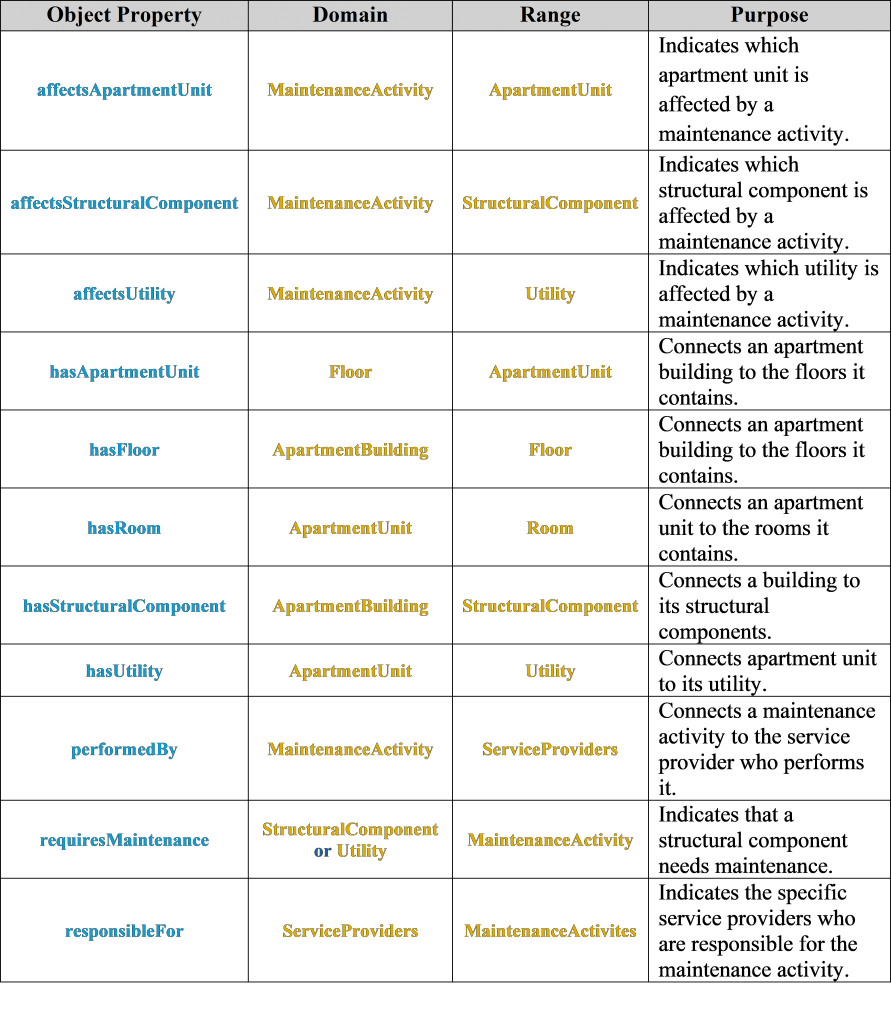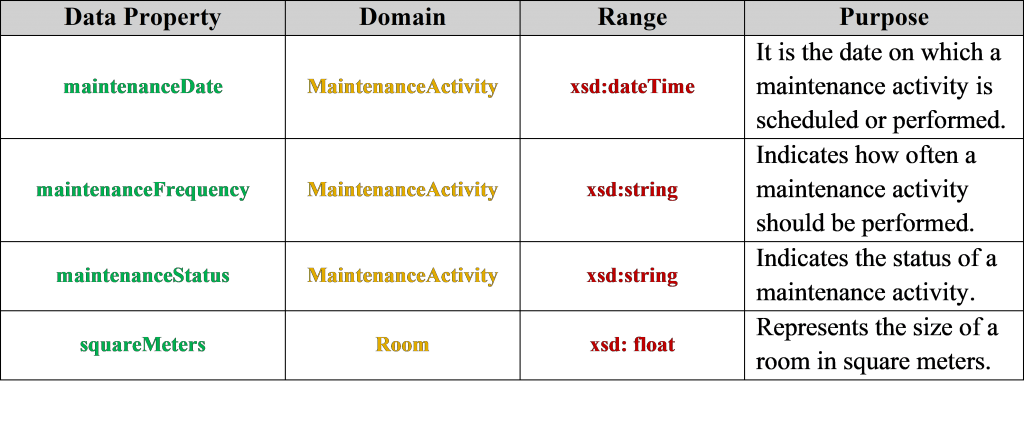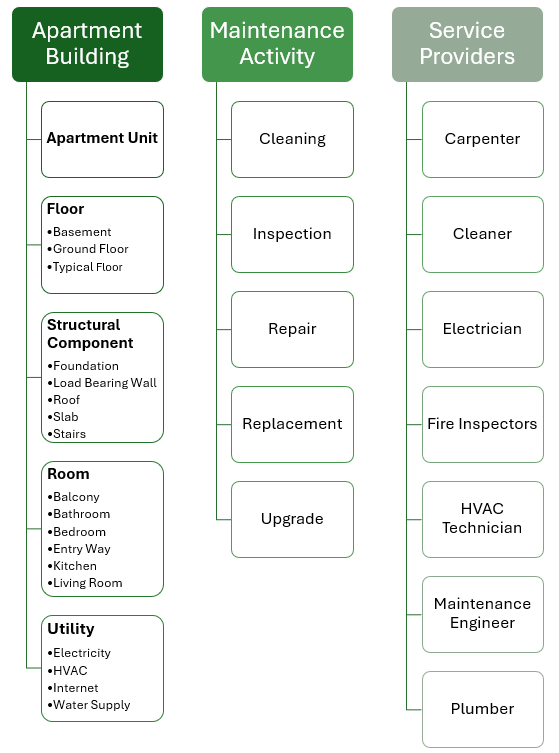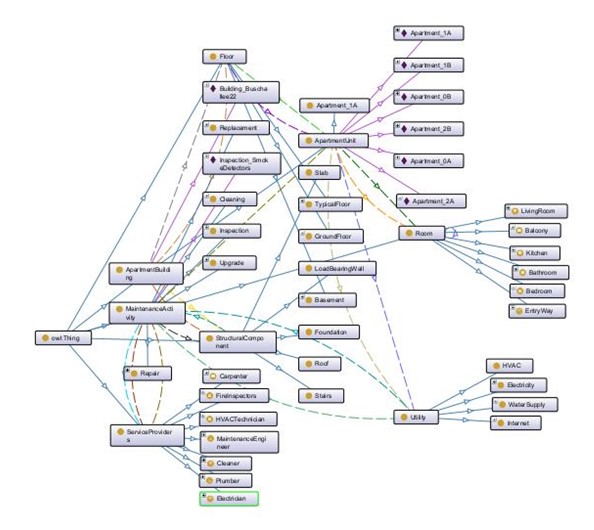Seychelle Ann Dagus | Student Number: 0508078 | s.dagus@campus.tu-berlin.de
Introduction
This ontology focuses on a three-story apartment building located in Buschallee, Pankow, Berlin. This building was built by Bruno-Taut in 1925[1]. So, this building is already about a hundred years old. The building comprises two apartment units for each floor (Zweispänner), and each apartment unit contains different rooms and utilities. This ontology will provide a systematic framework to track and manage maintenance tasks for structural parts and utilities in the building. It will make it easy to connect with service providers and companies who monitor utilities to help manage buildings effectively.

Figure 1. Housing stock by age of construction 2022[2]
According to the Housing Market Report Berlin (2024), the population in Berlin has increased significantly due to migration gain causing a continuous increase in rent prices. The demographic forecast also predicts that Pankow will have the largest population growth in Berlin in the future.[3] From Figure 1, we can see that old buildings constructed until 1918 are 25.5% and old buildings constructed from 1919-1948 have 13.8% of the housing stock. Despite new buildings being built, it is still not enough to accommodate the housing demand in Berlin. Therefore, maintenance of older buildings should still be considered. This ontology is significant to the current housing situation in Berlin. Older buildings need maintenance to keep up with the rising population and to be able to accommodate more residents. This ontology will help in mitigating housing problems by improving the building’s safety.
Competence Questions in developing an ontology
To create this ontology, the steps of developing an ontology suggested by Noy and Mcguinness[4] were followed. We also answer the questions for developing an ontology.[5]
What is the purpose?
- This ontology will enable efficient tracking and management of maintenance activities for structural components, utilities, and apartment units.
- This ontology will also offer a framework to know the relationships between the structural components, utilities, service providers, and maintenance activities.
What is the scope?
- This ontology includes the classes such as the building’s structural components, including rooms and utilities.
- Modeling the relationships between the building and each apartment unit per floor.
- To get information on maintenance activities, scheduling, and the service providers responsible for each maintenance.
Who are the intended users?
- This ontology will be beneficial for Landlords to easily monitor and manage the maintenance needs and requirements of the apartment building.
- It will also be useful for Service Providers such as Fire Inspectors, Plumbers, Electricians, Carpenters, HVAC Technicians, and Cleaning Staff, to schedule and record maintenance activities.
- Lastly, it will serve as a guide for Maintenance Engineers to ensure the building’s safety compliance with the standard.
What is the intended use?
- Managing and scheduling maintenance tasks for structural components, apartment units, and utilities.
- To help in supporting decision-making by giving insights into recurring maintenance problems.
Developing the Ontology: Building an OWL Ontology for Apartment Building
According to Noy and Mcguiness (2001), the first step in developing an ontology is to determine the domain and scope of the ontology. For an apartment building ontology that focuses on the repair and maintenance, the following concepts are considered:
- Defining the Classes and the Class Hierarchy
Classes and Subclasses defined in Protégé are as follows:


- Figure 2. Classes and Subclasses defined in Protégé
- Defining the Object and Data Properties of Classes
To provide more information for the classes to answer the competency questions, we need to define the Object and Data Properties. Table 1 shows the Object Properties of classes defined in Protégé. This will enable us to determine the relationship between two classes that have connected concepts.
Table 1. Object Properties of Classes defined in Protégé

Table 2 shows the Data Properties of classes. This indicates the literal value of the class by using slot values such as dateTime, string, and float. These are important details used for practical applications like documenting maintenance dates, recording how long it took to do a specific maintenance task, and the status of the maintenance.
Table 1. Data Properties of Classes defined in Protégé

- Create Instances
Figure 3 shows an example of an Instance for a maintenance activity. In this example, Apartment 1A needs an inspection for the smoke detectors which are required to be inspected annually. It also shows the date and time of the scheduled inspection as well as the status of the task.

Figure 3. Smore Detector Maintenance for Apartment 1A
- Visualizing the Ontology using OntoGraf
Figure 4. shows the Ontology of the Apartment Building and its structural components, maintenance activities, and service providers. It shows the interrelationships between all these elements using directed arrows.
Figure 4. Ontograf of the Apartment Building
Engineering Examples of the Ontology
- Structural Safety Inspections After an Earthquake
If an earthquake happens, the structural integrity of the apartment building should be the top priority. The ontology offers an ordered method for post-earthquake inspections, such that every structural element, from load-bearing walls to the roof to the foundation, is subjected for assessment. For example, “Which structural components need to be inspected, and which service providers are supposed to do it?” can be a starting point to create an inspection plan and organize maintenance activities for each floor. The relationship between structural components and maintenance activities such as inspection and repair and their connection to service providers means that the appropriate professional is assigned to each activity. This approach focuses on safety by minimizing supervision and allowing a high level of systematic, detailed assessment of the building. As a result, the ontology facilitates not only the recovery process of the building after an emergency but also the maintenance of safe protocols.
- HVAC Maintenance in Apartment Units
If in the case of an HVAC system in a typical floor apartment unit, the cooling system shows a behaviour of inconsistent cooling, the ontology plays a key role to guide a maintenance procedure. Applying the ontology, if we ask a question like “What is the list for the required maintenance operations to be conducted on an HVAC system, and who can conduct it?” helps identify the tasks necessary for resolving the issue. The operation of the HVAC correlates to the needed maintenance activities like inspection, cleaning, and repair, but at the same time, the ontology correlates the needed maintenance activity to who can do it (HVAC technician) through specifically defined object properties. Therefore, not only does an appropriate professional get sent to complete the task, but it creates scheduled workflows that may suggest cleaning first, then an inspection, and then a third time to repair. In addition, because these connections and maintenance activities are facilitated through the ontology, it reduces human error, eliminates downtime, and the maintenance task workflow is effective.
- Water Supply Repair in Utility Systems
When a water supply network serving multiple units on a unit of an apartment building develops a leak, the ontology becomes usable in a process of efficient repair. By querying “Which utilities are impacted by water supply issues, and what activities are required for repair? And who will be responsible for the repair?”. The ontology immediately detects all apartments having been impacted as well as water supply utilities. It bridges the utility to related maintenance activity (repair) and connects those tasks to service professionals (Plumbers). Moreover, the object properties of the ontology, such as affectedBy, give an insight into how the problem can affect different parts of the building. Not only it facilitates the assignment of tasks and resources in a structured format but also attenuates the interruption of water supply for the tenants. Through a quick response, the ontology decreases repair time, stops further deterioration of the structure, and makes it greater for utility maintenance in apartment units.
References:
[1] Berlin.de. Weißensee: A district of Berlin. Retrieved from https://www.berlin.de/en/districts/weissensee/909436-6654157-weissensee.en.html
[2] Investitionsbank Berlin. (2023). Wohnungsmarktbericht 2023: Wohnen in Berlin. Retrieved from https://www.ibb.de/de/ueber-uns/publikationen/wohnungsmarktbericht/2023.html
[3] Berlin Hyp AG. (2024). Housing market report Berlin 2024. Retrieved from https://www.berlinhyp.de/en/media/newsroom/housing-market-report-berlin-2024
[4] Noy, N. F., & McGuinness, D. L. (2001). Ontology development 101: A guide to creating your first ontology. https://www.stanford.edu/class/cs520/2001/ontology_development101.pdf
[5] Fernández-López, M., Gómez-Pérez, A., & Juristo, N. (1997). Methontology: from ontological art towards ontological engineering.

